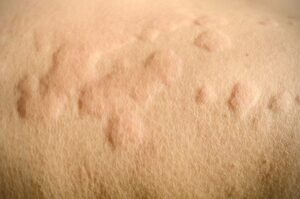October 23, 2025 | Black & Kletz Allergy

Individual skin lesions typically subside in less than 24 hours, although an individual may have multiple crops of lesions in a single day. In some individuals however, complex hives caused by the inflammation of blood vessels in the skin may last more than 24 hours and leave residual marks on the skin after their resolution.
In a majority of instances, the episodes of hives subside spontaneously within a few weeks, however, if the condition lasts longer than 6 weeks, it is termed chronic urticaria. Alternatively, if the hives last shorter than 6 weeks in duration, the condition is referred to as acute urticaria. Sometimes hives are associated with the swelling of soft tissues (i.e., angioedema) commonly involving the eyelids, lips, throat, and/or tongue. It should be noted that angioedema can occur anywhere on or in the body as they can also appear internally.
The itching (i.e., pruritus) severity can run the spectrum from very mild to very severe and may be present both during day and/or night. It can impact one’s quality of sleep at night, impair one’s concentration in school or work during the daytime, thus adversely impacting one’s overall quality of life.
Common triggers for hives may include a side effect of a medication, allergic sensitivity to foods, and/or viral infections. In the vast majority of cases however, there will be no identifiable triggering factor(s) and as a result, it is referred to as chronic spontaneous urticaria (CSU). If exposure to cold, heat, water, vibration, or pressure triggers hives, it is characterized as chronic inducible urticaria (CIU).
A thorough and comprehensive history of the onset, duration, severity, and exposure to possible triggers may provide clues to the causation of the condition. A few screening laboratory tests are usually obtained in order to rule out systemic disorders which could manifest as chronic spontaneous urticaria. In most instances (approximately 95%) however, the screening tests will be normal an no identifiable cause will be found.
Although no cause can be identified in most cases, the treatment of hives is usually quite manageable. Medications can be very helpful in relieving the bothersome itching that is often associated with hives. Medications are also used to lessen the frequency and severity of the actual hives themselves. Histamine, a chemical released into the blood stream from both mast cells and basophils (i.e., types of white blood cells) is the principle chemical mediator that causes the clinical manifestations of both acute and chronic urticaria.
Medications which block the actions of histamine on the skin are usually first line treatment options. Second-generation antihistamines such as Claritin (i.e., loratadine), Allegra (i.e., fexofenadine), Zyrtec (i.e., cetirizine), and Xyzal (i.e., levocetirizine) are less sedating than the first-generation antihistamines such as Benadryl (i.e., diphenhydramine) and Atarax (i.e., hydroxyzine). It should be noted that many patients do not respond adequately to the regular doses of antihistamines used in the treatment of environmental allergies. Depending on the response, the doses of these agents may be gradually increased up to 4 times the regular daily dose, if recommended by the allergist and monitored closely. If the symptoms continue to be bothersome, first-generation antihistamines such as Palgic (i.e., carbinoxamine) or Periactin (i.e., cyproheptadine) can be added to the regimen.
As we understand more and more about the underlying immunological mechanisms and the molecular mediators of these conditions, newer medications targeting these pathways and/or blocking these molecules are being developed.
When antihistamines alone are ineffective, biological medications such as Xolair (i.e., omalizumab) and Dupixent (i.e., dupilumab) can offer significant relief from symptoms. Xolair was the first biologic approved for chronic spontaneous urticaria and many patients have greatly benefited from this medication over the past several years. It is usually given as an injection under the skin (i.e., subcutaneously or SQ) every 4 weeks. Dupixent was the second biologic medication approved for chronic spontaneous urticaria in April 2025 and is administered as a subcutaneous injection (SQ) every 2 weeks.
The most recently approved medication for chronic spontaneous urticaria called Rhapsido (i.e., remibrutinib) inhibits an inflammatory mediator called Bruton’s tyrosine kinase (BTK). BTK is an intracellular protein expressed in mast cells, basophils, as well as other cells and is involved in intracellular signaling. Clinical trials have shown a 70% reduction in hives vs. a 39% decrease in hives with the placebo at week 12. It has also been shown to reduce itching by 67% vs. a decrease of 42% with the placebo.
Rhapsido got approval from the FDA in September 2025 for the treatment of chronic hives in adults with no known external triggers and who are not controlled with antihistamines. The dosage is a 25 mg pill taken by mouth twice daily. Rhapsido may be taken with or without food. It would be a good option for patients who are needle phobic or in patients who do not respond adequately to Xolair or Dupixent.
The board certified allergy specialists at Black & Kletz Allergy will promptly answer any questions you may have regarding both acute or chronic urticaria (i.e., hives) or any related condition such as generalized itching (i.e., pruritus) or swelling episodes (i.e., angioedema). Our allergy doctors have been diagnosing and treating hives in the Washington, DC, Northern Virginia, and Maryland metropolitan area for more than 50 years. We have 3 convenient locations in the Washington, DC metro area with offices in Washington, DC, McLean, VA (Tysons Corner, VA), and Manassas, VA. There is on-site parking at each location and both the Washington, DC and McLean, VA offices are Metro accessible. There is a free shuttle that runs between our McLean, VA office and the Spring Hill metro station on the silver line. To schedule an appointment, please call us at any one of our 3 locations. Alternatively, you can click Request an Appointment and we will respond within 24 hours by the next business day. Black & Kletz Allergy is dedicated in providing the most current diagnostic and treatment methods in the field of allergy, asthma, and immunology in a caring and professional setting.












